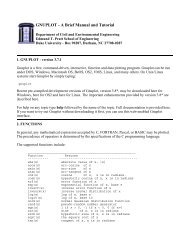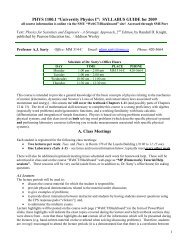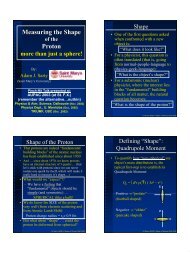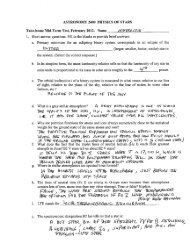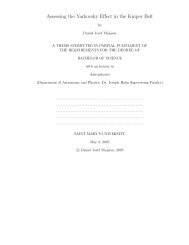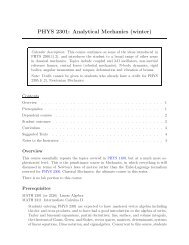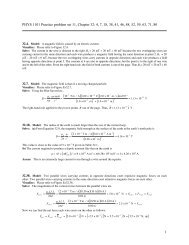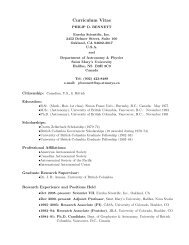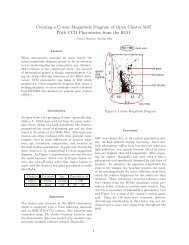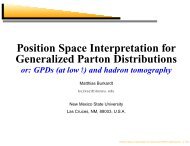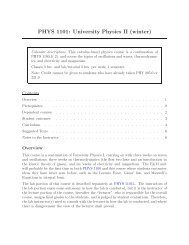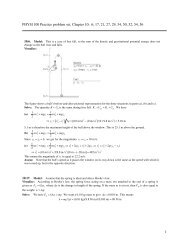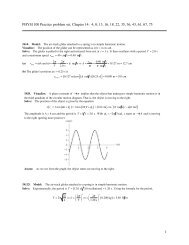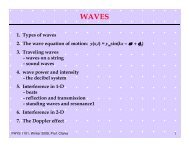1 PHYS 1101 Practice problem set 2, Chapter 20: 9, 12, 16, 19, 32 ...
1 PHYS 1101 Practice problem set 2, Chapter 20: 9, 12, 16, 19, 32 ...
1 PHYS 1101 Practice problem set 2, Chapter 20: 9, 12, 16, 19, 32 ...
- No tags were found...
Create successful ePaper yourself
Turn your PDF publications into a flip-book with our unique Google optimized e-Paper software.
<strong>PHYS</strong> <strong>1101</strong> <strong>Practice</strong> <strong>problem</strong> <strong>set</strong> 2, <strong>Chapter</strong> <strong>20</strong>: 9, <strong>12</strong>, <strong>16</strong>, <strong>19</strong>, <strong>32</strong>, 36, 47, 54, 61, 67, 74, 80<strong>20</strong>.9. Model: The wave is a traveling wave on a stretched string.Solve: The wave speed on a string whose radius is R, length is L, and mass density is ρ is vstring = TSµ withIf the string radius doubles, then2m ρV ρπ R Lµ = = = = ρπ RL L LTSstring′string= = = =2vρπ( 2R)v 280 m/s2 22140 m/s<strong>20</strong>.<strong>12</strong>. Model: The wave is a traveling wave.Solve: (a) A comparison of the wave equation with Equation <strong>20</strong>.14 yields: A = 3.5 cm, k = 2.7 rad/m, ω = <strong>12</strong>4 rad/s,and φ0= 0 rad . The frequency is(b) The wavelength is(c) The wave speed v = λ f = 45.9 m/s .<strong>12</strong>4 rad/sf = ω<strong>19</strong>.7 Hz2π= 2π=2π2πλ = = = 2.33 mk 2.7 rad/m<strong>20</strong>.<strong>16</strong>. Visualize: Please refer to Figure Ex<strong>20</strong>.<strong>16</strong>.Solve: The amplitude of the wave is the maximum displacement which is 6.0 cm. The period of the wave is0.60 s, so the frequency f = 1 T = 1 0.60 s = 1.67 Hz . The wavelength isλ = v 2 m/s1.2 mf= 1.667 Hz=1
<strong>20</strong>.<strong>19</strong>. Visualize:Solve: For a sinusoidal wave, the phase difference between two points on the wave is given by Equation <strong>20</strong>.28:φ φ φ 2π 2π λ2πλ λ φ( r r ) ( 40 m 30 m) ( 10 m)∆ =2−1=2−1= − ⇒ = ∆∆ φ = 2πfor two points on adjacent wavefronts and ∆ φ = 4πfor two points separated by 2λ. Thus, λ = 10 mwhen ∆ φ = 2π, and λ = 5 m when ∆ φ = 4π. The crests corresponding to these two wavelengths are shown in thefigure. One can see that a crest of the wave passes the 40 m-listener and the 30 m-listener simultaneously. Thelowest two possible frequencies will occur for the largest two possible wavelengths, which are 10 m and 5 m. Thus,the lowest frequency isThe next highest frequency is f2= 68 Hz .v 340 m/sf1= = = 34 Hzλ 10 m<strong>20</strong>.<strong>32</strong>. Solve: The energy delivered to the eardrum in time t is E = Pt, where P is the power of the wave. Theintensity of the wave is I = P a where a is the area of the ear drum. Putting the above information together, we have2( ) π ( ) π ( ) ( )2 −3 2 −3 −6E = Pt = Ia t = I r t = 2.0 × 10 W/m 3.0 × 10 m 60 s = 3.39 × 10 J<strong>20</strong>.36. Model: The frequency of the opera singer’s note is altered by the Doppler effect.Solve: (a) Using 90 km/hr = 25 m/s, the frequency as her convertible approaches the stationary person isff600 Hz= 0+1 − v 25 m/sSv= =1 − 343 m/s647 Hz(b) The frequency as her convertible recedes from the stationary person isff600 Hz= 0−1 + v 25 m/sSv= =1+343 m/s559 Hz2
<strong>20</strong>.61. Solve: According to Equation <strong>20</strong>.28, the phase difference between two points on a wave is ∆ φ =( − )2πr r2 1The wavelength isλ . For the first point and second point,<strong>12</strong>( ) ( ) ( )2 2 2r = 1.0 cm − 0 cm + 3.0 cm − 0 cm + 2.0 cm − 0 cm = 3.742 cm( ) ( ) ( )2 2 2r = −1.0 cm − 0 cm + 1.5 cm − 0 cm + 2.5 cm − 0 cm = 3.082 cmλ = v 346 m/s0.02641 mf= 13,100 Hz= = 2.641 cm( )2π 3.742 cm − 3.082 cm π π 180°⇒ ∆ φ = = rad = rad × = 90°2.641 cm 2 2 π rad<strong>20</strong>.67. Model: A sinusoidal wave is traveling along a stretched string.Solve: From Equation <strong>20</strong>.17 and Equation <strong>20</strong>.<strong>20</strong>, v y max = ωA and a y max = ω 2 A. These two equations can becombined to give2aymax <strong>20</strong>0 m/sωmax 2.0 m/sω = = = 100 rad/s ⇒ f = = 15.9 Hz ⇒ A = = = 2.0 cmv 2.0 m/s 2πω 100 rad/sy maxv y<strong>20</strong>.74. Model: The sound generator’s frequency is altered by the Doppler effect. The frequency increases asthe generator approaches the student, and it decreases as the generator recedes from the student.Solve: The generator’s speed is100vS= rω = r( 2π f ) = ( 1.0 m)2 π ⎛ ⎜ rev/s ⎞ = 10.47 m/s60⎟⎝ ⎠The frequency of the approaching generator isf0600 Hzf = 6<strong>19</strong> Hz+1 − v 10.47 m/sSv= =1−343 m/sDoppler effect for the receding generator, on the other hand, isff600 Hz= 0−1 + v 10.47 m/sSv= =1 +343 m/s582 HzThus, the highest and the lowest frequencies heard by the student are 6<strong>19</strong> Hz and 582 Hz.4
<strong>20</strong>.80. Model: The wave pulse is a traveling wave on a stretched string. The two masses hanging from the steelwire are in static equilibrium.Visualize: Please refer to Figure CP<strong>20</strong>.80 in your textbook.Solve:The wave speed along the wire isUsing Equation <strong>20</strong>.2,v4.0 mvwire= = <strong>16</strong>6.7 m/s0.024 sTT= <strong>16</strong>6.7 m/s = = ⇒ T = <strong>20</strong>8.4 Nµ1 1wire 1Because point 1 is in static equilibrium, with Frnet= 0,r( )( )( 0.060 kg 8.0 m)T1Fnet = T1 − T2 cos40° ⇒ T2= = 2721 Nxcos40°( 272.1 N)sin40°Fnet = T2 sin40° − w = 0 N ⇒ w = mg = T2 sin40° ⇒ m = = 17.8 kgy29.8 m/s5



